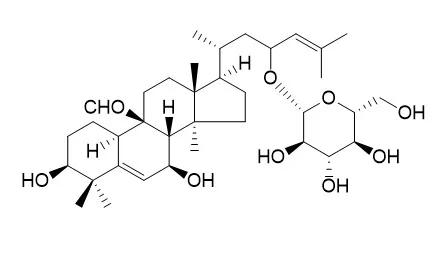| In vitro: |
| Phytomedicine. 2011 Dec 15;19(1):32-7. | | Saponins from the traditional medicinal plant Momordica charantia stimulate insulin secretion in vitro.[Pubmed: 22133295 ] | The antidiabetic activity of Momordica charantia (L.), Cucurbitaceae, a widely-used treatment for diabetes in a number of traditional medicine systems, was investigated in vitro. Antidiabetic activity has been reported for certain saponins isolated from M. charantia.
METHODS AND RESULTS:
In this study insulin secretion was measured in MIN6 β-cells incubated with an ethanol extract, saponin-rich fraction, and five purified saponins and cucurbitane triterpenoids from M. charantia, 3β,7β,25-trihydroxycucurbita-5,23(E)-dien-19-al (1), momordicine I (2), Momordicine II (3), 3-hydroxycucurbita-5,24-dien-19-al-7,23-di-O-β-glucopyranoside (4), and kuguaglycoside G (5). Treatments were compared to incubation with high glucose (27 mM) and the insulin secretagogue, glipizide (50 μM). At 125 μg/ml, an LC-ToF-MS characterized saponin-rich fraction stimulated insulin secretion significantly more than the DMSO vehicle, p=0.02. At concentrations 10 and 25 μg/ml, compounds 3 and 5 also significantly stimulated insulin secretion as compared to the vehicle, p≤0.007, and p=0.002, respectively.
CONCLUSIONS:
This is the first report of a saponin-rich fraction, and isolated compounds from M. charantia, stimulating insulin secretion in an in vitro, static incubation assay. | | Z Naturforsch C. 2006 Jan-Feb;61(1-2):81-6. | | Cucurbitane glucosides from Momordica charantia leaves as oviposition deterrents to the leafminer, Liriomyza trifolii.[Pubmed: 16610222 ] |
METHODS AND RESULTS:
The American serpentine leaf mining fly, Liriomyza trifolii, whose larva feeds on more than 120 plant species is well characterized by its high degree of polyphagy. Observations on the oviposition behavior by L. trifolii demonstrated that among cucurbitaceous plants, Momordica charantia is rarely attacked by L. trifolii. The methanol extract of M. charantia leaves strongly deterred the females from ovipositing on kidney bean leaves treated at a concentration of 1 g leaf equivalent extract/ml. Analysis of the polar fraction of the methanol extract of M. charantia leaves resulted in the isolation of a novel cucurbitane glucoside, 7-O-beta-D-glucopyranosyl-3,23-dihydroxycucurbita-5,24-dien-19-al, named momordicine IV, along with another known compound, Momordicine II.
CONCLUSIONS:
Momordicine II and IV deterred oviposition by L. trifolii significantly when bioassays were carried out on kidney bean leaves treated at 75.6 and 20.3 microg/cm2 leaf surface, respectively. There was no synergistic effect on oviposition deterrent when the two compounds were combined in their natural abundance. |
|






 Cell. 2018 Jan 11;172(1-2):249-261.e12. doi: 10.1016/j.cell.2017.12.019.IF=36.216(2019)
Cell. 2018 Jan 11;172(1-2):249-261.e12. doi: 10.1016/j.cell.2017.12.019.IF=36.216(2019) Cell Metab. 2020 Mar 3;31(3):534-548.e5. doi: 10.1016/j.cmet.2020.01.002.IF=22.415(2019)
Cell Metab. 2020 Mar 3;31(3):534-548.e5. doi: 10.1016/j.cmet.2020.01.002.IF=22.415(2019) Mol Cell. 2017 Nov 16;68(4):673-685.e6. doi: 10.1016/j.molcel.2017.10.022.IF=14.548(2019)
Mol Cell. 2017 Nov 16;68(4):673-685.e6. doi: 10.1016/j.molcel.2017.10.022.IF=14.548(2019)